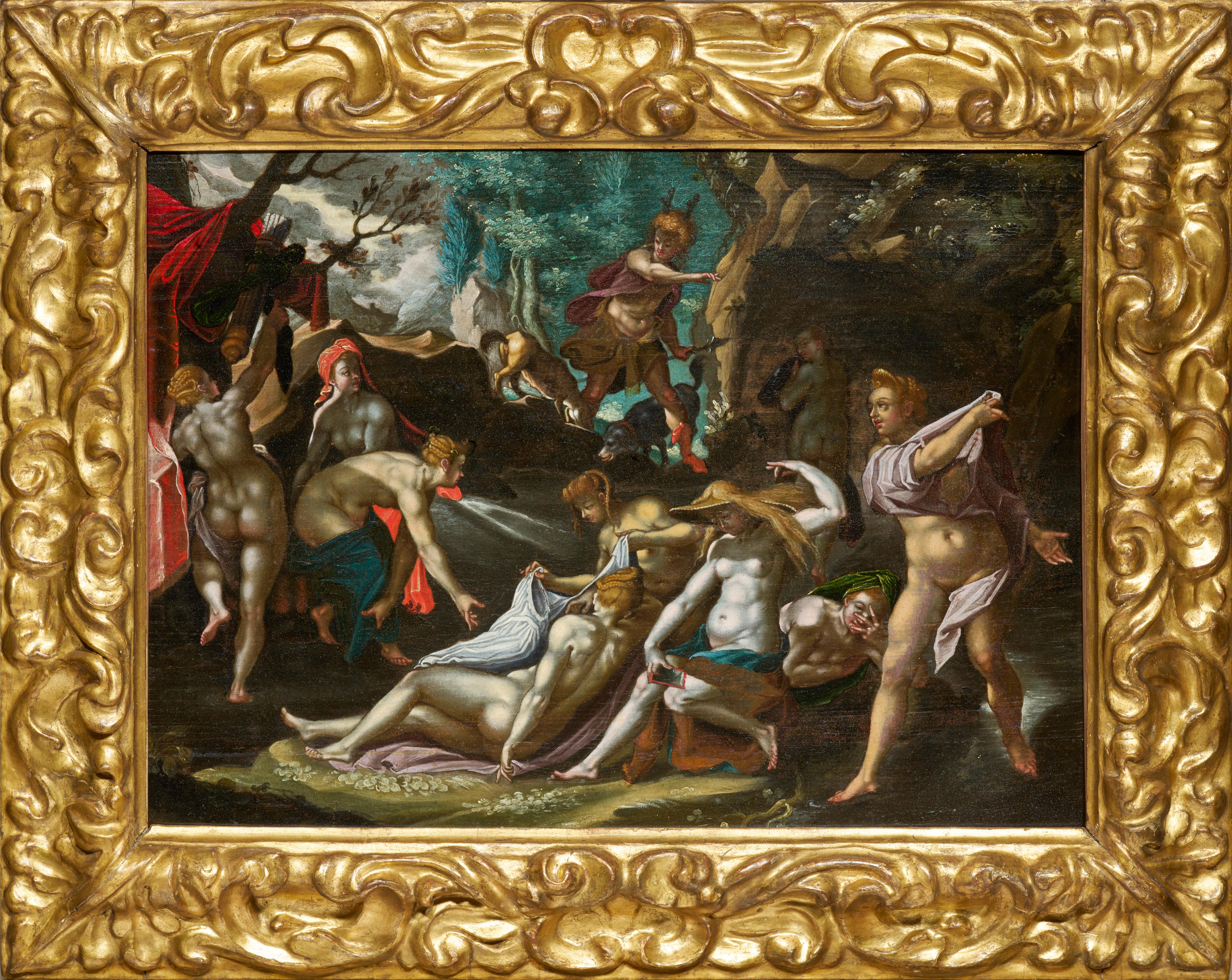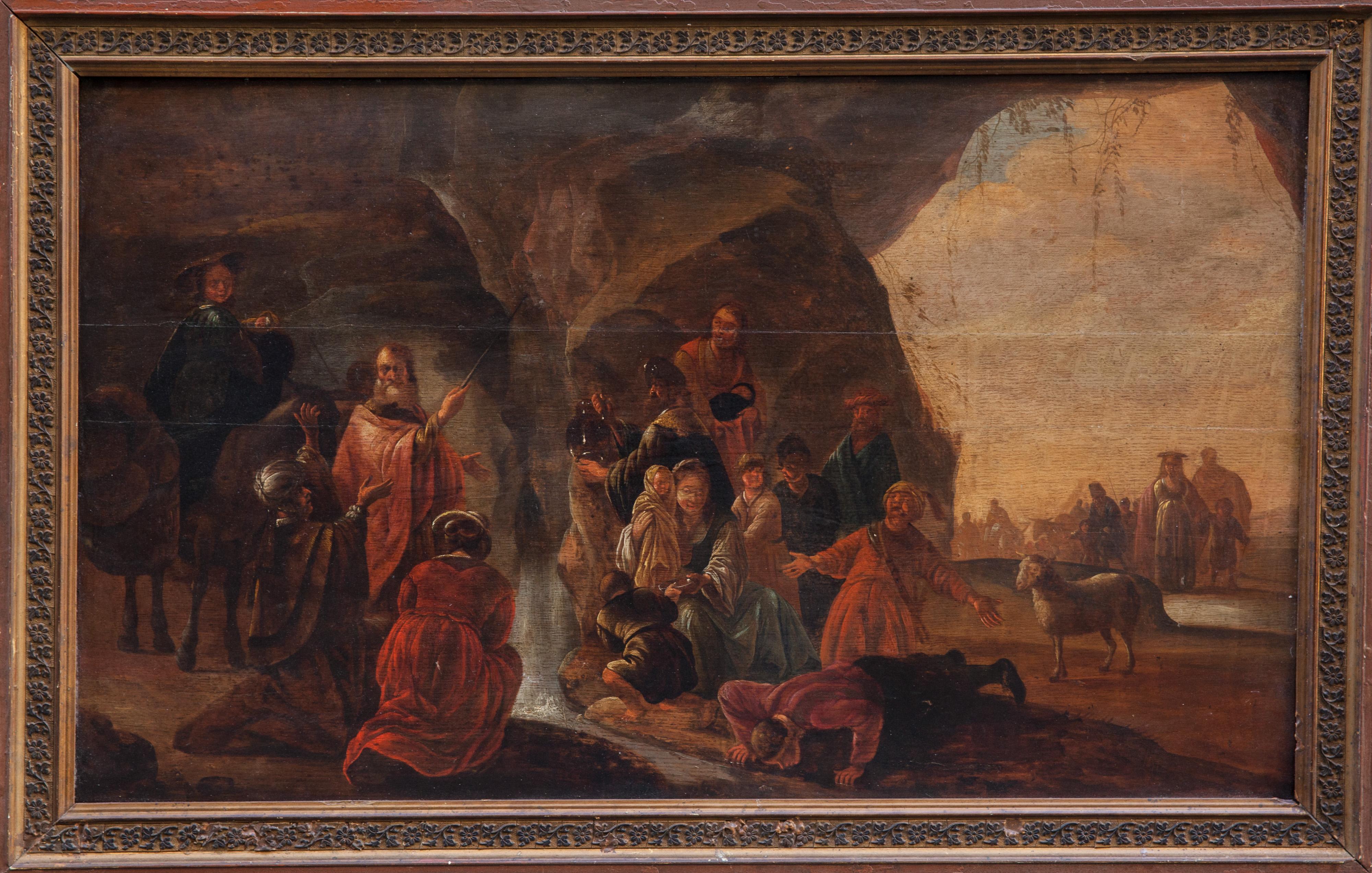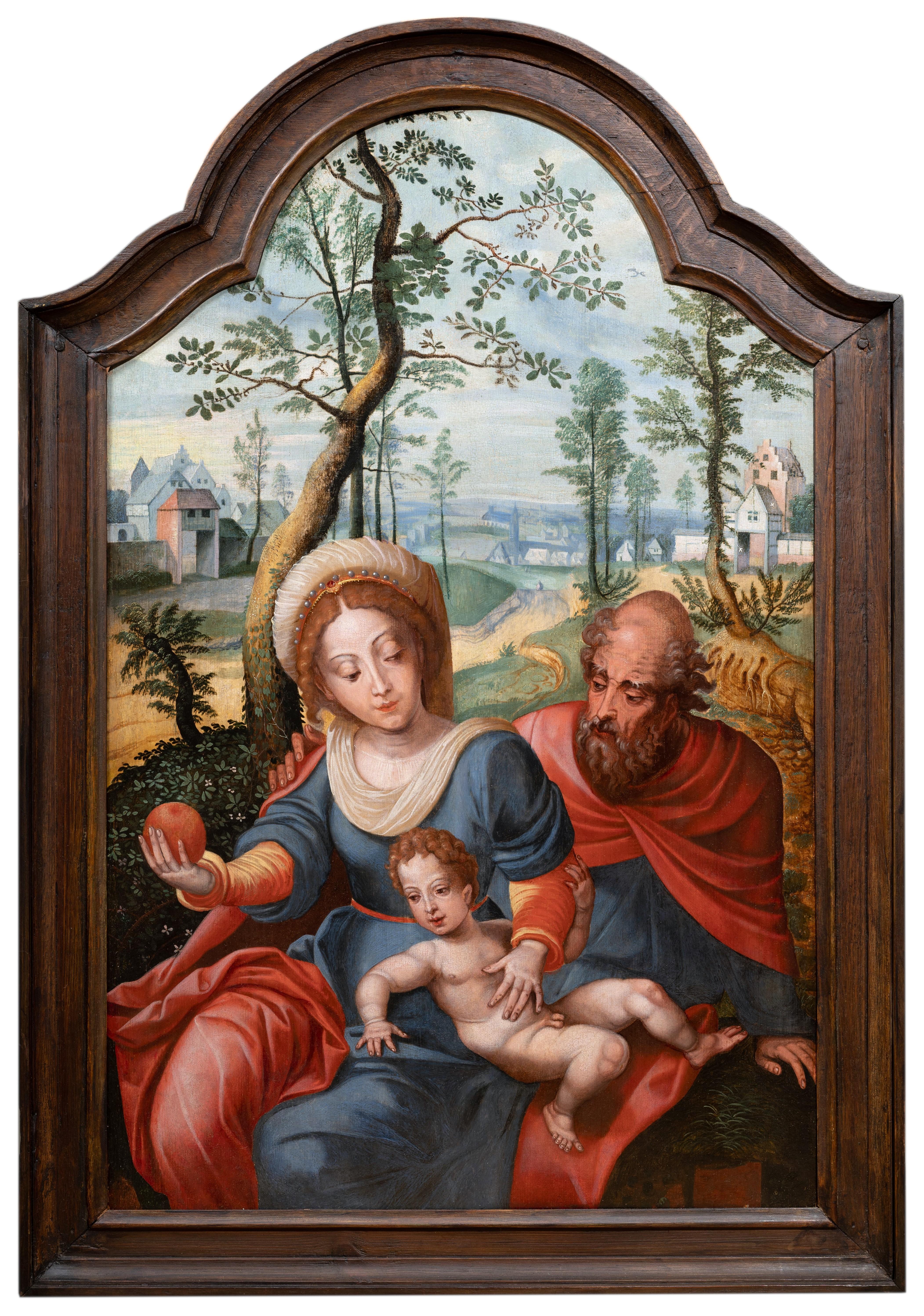Items Similar to Esther in the Women's House of Ahasuerus
Want more images or videos?
Request additional images or videos from the seller
1 of 5
Artus WolfortEsther in the Women's House of Ahasuerus
About the Item
Born in Antwerp, Artus Wolffordt received his training in Dordrecht where he became a master in 1603 at the age of twenty-two. He returned to his native city in 1615 and initially worked as an assistant to Otto van Veen. By 1617, he had received various important commissions, including the altarpieces of the Ascension and Assumption of the Virgin for the Church of St. Paul in Antwerp. The majority of Wolffordt's oeuvre, however, consists of compositions intended for the open market and private individuals. Several paintings (such as his series of the Twelve Apostles, the Four Evangelists, and Four Fathers of the Church) exist in various versions, of differing quality, suggesting that Wolffordt maintained a workshop. Two of his assistants, Pieter van Lint and Pieter van Mol, are in fact known to have made replicas of his paintings and were both greatly influenced by him.
The present painting was first identified as a work of Wolffordt's by Professor Leonard Slatkes, in February 2001. The existence of perhaps as many as ten versions of the composition attests to its evident popularity. Four of these are in public collections in Europe: the Victoria & Albert Museum, London, (Inv. D. 10); the Palazzo Vecchio Florence; the Staatliche Gemäldegalerie in Cassel (No. 281); and at Wilton House, England. A signed version was sold in The Hague in 1942 and other examples have been recorded in the Adalbert von Lanna Collection near Prague, the Frederick Stern Collection in Los Angeles, a Swedish Private Collection, and on the art market, Heidelberg. It is possible that the either the Los Angeles or Prague versions (assuming that they are distinct) may be identifiable with the present panel.
- Creator:Artus Wolfort
- Dimensions:Height: 19.75 in (50.17 cm)Width: 29.5 in (74.93 cm)
- Medium:
- Movement & Style:
- Period:
- Condition:
- Gallery Location:New York, NY
- Reference Number:1stDibs: LU1025797232

About the Seller
5.0
Recognized Seller
These prestigious sellers are industry leaders and represent the highest echelon for item quality and design.
Established in 1997
1stDibs seller since 2012
17 sales on 1stDibs
Typical response time: 11 hours
- ShippingRetrieving quote...Ships From: New York, NY
- Return PolicyThis item cannot be returned.
More From This SellerView All
- Portrait of a ManLocated in New York, NYProvenance: with Leo Blumenreich and Julius Böhler, Munich, 1924 Dr. Frederic Goldstein Oppenheimer (1881-1963), San Antonio, Texas; by whom given to: Abraham M. Adler, New York, un...Category
16th Century Old Masters Portrait Paintings
MaterialsOil, Panel
- Madonna and Child with the Infant Saint John the BaptistLocated in New York, NYInscribed, reverse: Fr Brina Provenance: Private Collection, New Jersey. Francesco Brina was one of the “Studiolo” painters, responsible for the panel of Neptune and Amphitrite in F...Category
16th Century Old Masters Paintings
MaterialsOil, Wood Panel
- The Resurrection of ChristLocated in New York, NYProvenance: with “Mr. Scheer,” Vienna, by July 1918; where acquired by: Jindřich Waldes, Prague, 1918–1941; thence by descent to: Private Collection, New York Literature: Rudolf Kuchynka, “České obrazy tabulové ve Waldesově obrazárně,” Památky archeologické, vol. 31 (1919), pp. 62-64, fig. 5. Jaroslav Pešina, “K datování deskových obrazů ve Waldesově obrazárně,” Ročenka Kruhu pro Pěstování Dějin Umění: za rok (1934), pp. 131-137. Jaroslav Pešina, Pozdně gotické deskové malířství v Čechách, Prague, 1940, pp. 150-151, 220. Patrik Šimon, Jindřich Waldes: sběratel umění, Prague, 2001, pp. 166, 168, footnote 190. Ivo Hlobil, “Tři gotické obrazy ze sbírky Jindřicha Waldese,” Umění, vol. 52, no. 4 (2004), p. 369. Executed sometime in the 1380s or 1390s by a close associate of the Master of the Třeboň Altarpiece, this impressive panel is a rare work created at the royal court in Prague and a significant re-discovery for the corpus of early Bohemian painting. It has emerged from an American collection, descendants of the celebrated Czech industrialist and collector Jindřich Waldes, who died in Havana fleeing Nazi-occupied Europe. The distinctive visual tradition of the Bohemian school first began to take shape in the middle of the fourteenth century after Charles IV—King of Bohemia and later Holy Roman Emperor—established Prague as a major artistic center. The influx of foreign artists and the importation of significant works of art from across Europe had a profound influence on the development of a local pictorial style. Early Italian paintings, especially those by Sienese painters and Tommaso da Modena (who worked at Charles IV’s court), had a considerable impact on the first generation of Bohemian painters. Although this influence is still felt in the brilliant gold ground and the delicate tooling of the present work, the author of this painting appears to be responding more to the paintings of his predecessors in Prague than to foreign influences. This Resurrection of Christ employs a compositional format that was popular throughout the late medieval period but was particularly pervasive in Bohemian painting. Christ is shown sitting atop a pink marble sarcophagus, stepping down onto the ground with one bare foot. He blesses the viewer with his right hand, while in his left he holds a triumphal cross with a fluttering banner, symbolizing his victory over death. Several Roman soldiers doze at the base of the tomb, except for one grotesque figure, who, beginning to wake, shields his eyes from the light and looks on with a face of bewilderment as Christ emerges from his tomb. Christ is wrapped in a striking red robe with a blue interior lining, the colors of which vary subtly in the changing light. He stands out prominently against the gold backdrop, which is interrupted only by the abstractly rendered landscape and trees on either side of him. The soldiers’ armor is rendered in exacting detail, the cool gray of the metal contrasting with the earth tones of the outer garments. The sleeping soldier set within a jumble of armor with neither face nor hands exposed, is covered with what appears to be a shield emblazoned with two flies on a white field, somewhat resembling a cartouche (Fig. 1). This may be a heraldic device of the altarpiece’s patron or it may signify evil, referencing either the Roman soldiers or death, over both of which Christ triumphs. This painting formed part of the collection assembled by the Czech industrialist and founder of the Waldes Koh-i-noor Company, Jindřich Waldes, in the early twentieth century. As a collector he is best remembered for establishing the Waldes Museum in Prague to house his collection of buttons (totaling nearly 70,000 items), as well as for being the primary patron of the modernist painter František Kupka. Waldes was also an avid collector of older art, and he approached his collecting activity with the goal of creating an encyclopedic collection of Czech art from the medieval period through to the then-present day. At the conclusion of two decades of collecting, his inventory counted 2331 paintings and drawings, 4764 prints, and 162 sculptures. This collection, which constituted the Waldesova Obrazárna (Waldes Picture Gallery), was first displayed in Waldes’ home in Prague at 44 Americká Street and later at his newly built Villa Marie at 12 Koperníkova Street. This Resurrection of Christ retains its frame from the Waldes Picture Gallery, including its original plaque “173 / Česky malíř z konce 14 stol.” (“Czech painter from the end of the 14th century”) and Waldes’ collection label on the reverse. The Resurrection of Christ was one of the most significant late medieval panel...Category
15th Century and Earlier Old Masters Paintings
MaterialsTempera, Panel
- Baptism of ChristLocated in New York, NYProvenance: Achillito Chiesa, Milan Luigi Albrighi, Florence, by 1 July 1955 with Marcello and Carlo Sestieri, Rome, 1969 Private Collection, Connecticut Exhibited: Mount Holyoke College Art Museum, South Hadley, Massachusetts (on loan, 2012) Literature: Carlo Volpe, “Alcune restituzioni al Maestro dei Santi Quirico e Giulitta,” in Quaderni di Emblema 2: Miscellanea di Bonsanti, Fahy, Francisci, Gardner, Mortari, Sestieri, Volpe, Zeri, Bergamo, 1973, pp. 19-20, fig. 18, as by the Master of Saints Quiricus and Julitta (now identified as Borghese di Piero). This fine predella panel depicting the Baptism...Category
15th Century and Earlier Old Masters Figurative Paintings
MaterialsTempera, Wood Panel
- Julius Caesar on HorsebackBy Antonio TempestaLocated in New York, NYProvenance: Private Collection, South America Antonio Tempesta began his career in Florence, working on the decoration of the Palazzo Vecchio under the direction of Giorgio Vasari. He was a pupil first of Santi di Tito...Category
16th Century Old Masters Paintings
MaterialsOil, Canvas
- An Architectural Capriccio with the Preaching of an ApostleBy Giovanni Paolo PaniniLocated in New York, NYProvenance: Santambrogio Antichità, Milan; sold, 2007 to: Filippo Pernisa, Milan; by whom sold, 2010, to: Private Collection, Melide, Switzerland De Primi Fine Art, Lugano, Switzerland; from whom acquired, 2011 by: Private Collection, Connecticut (2011-present) Literature: Ferdinando Arisi, “Ancora sui dipinti giovanili del Panini,” Strenna Piacentina (Piacenza, 2009): pp. 48, 57, 65, fig. 31, as by Panini Ferdinando Arisi, “Panini o Ghisolfi o Carlieri? A proposito dei dipinti giovanili,” Strenna Piacentina, (Piacenza, 2010), pp. 100, 105, 116, fig. 101, as an early work by Panini, a variant of Panini’s painting in the Museo Cristiano, Esztergom, Hungary. This architectural capriccio is one of the earliest paintings by Giovanni Paolo Panini, the preeminent painter of vedute and capricci in 18th-century Rome. The attribution to Panini has been endorsed by Ferdinando Arisi, and a recent cleaning of the painting revealed the artist’s signature in the lower right. Like many of his fellow painters working in Rome during his day, Panini was not a native of the Eternal City. He first trained as a painter and stage designer in his hometown of Piacenza and moved to Rome at the age of 20 in November 1711 to study figure painting. Panini joined the workshop of Benedetto Luti (1666-1724) and from 1712 was living on the Piazza Farnese. Panini, like many before and after him, was spellbound by Rome and its classical past. He remained in the city for the rest of his career, specializing in depicting Rome’s most important monuments, as well as creating picturesque scenes like this one that evoked the city’s ancient splendor. The 18th century art historian Lione Pascoli, who likely knew Panini personally, records in his 1730 biography of the artist that when Panini came to Rome, he was already “an excellent master and a distinguished painter of perspective, landscape, and architecture.” Panini’s earliest works from this period still show the evidence of his artistic formation in Piacenza, especially the influence of the view painter Giovanni Ghisolfi (1623-1683). However, they were also clearly shaped by his contact in Rome with the architectural capricci of Alberto Carlieri...Category
18th Century Old Masters Figurative Paintings
MaterialsCanvas, Oil
You May Also Like
- Diana and Actaeon, a Mannerist painting after Joseph Heintz the ElderLocated in PARIS, FRThis painting seduced us with its rich colors. Depicting Diana and her companions surprised by Actaeon, it was inspired by an engraving by Aegidius Sadeler II after a painting by Jos...Category
17th Century Old Masters Nude Paintings
MaterialsOil, Wood Panel
- 17th Century By Paulus Bor Heraclitus and Democritus Oil on PanelLocated in Milano, Lombardia"Cassetta" frame in ebonized wood. Publications: - Expertise by Prof. Gianni Papi; - G. Papi, Un misto di grano e di pula. Scritti su Caravaggio e l’ambiente caravaggesco, Roma 2...Category
17th Century Old Masters Figurative Paintings
MaterialsOil, Wood Panel
- Study of a dogLocated in Amsterdam, NLStudy of a dog Oil on paper laid down on panel, 17.5 x 25.5 cm Provenance Private collection, the Netherlands Note: We are grateful to Mr Fred Meijer for his attribution to Ludolf de Jongh Ludolf de Jongh was the son of a shoemaker. When his father moved to Rotterdam, the young Ludolf decided to learn art rather than shoemaking and became a pupil of Cornelis Saftleven. Later he studied under Anthony Palamedes in Delft and still later with Jan van Bijlert in Utrecht. In 1635 he travelled to France with Francis Bacon. Seven years later, in 1642, he returned to the Netherlands when he heard that his mother had fallen ill. He set up a shop in Rotterdam, and his earliest signed paintings date from that year. According to Houbraken, his travels had caused him to speak French so fluently, that his parents had to learn French in order to speak with him. De Jongh’s work shows a strong influence from the Utrecht school of Caravaggio admirers, especially Jacob Duck...Category
Mid-17th Century Old Masters Animal Paintings
MaterialsPaper, Oil, Wood Panel
- Moses Strikes the Water from the Rock. XVII cent. Dutch school.Located in Firenze, ITMoses Strikes Water from the Rock Dutch school, XVII century. Workshop of Jacob de Wet (Haarlem, 1610-1675). Technique: Oil on oak wood panel, composed of 3 horizontal panels. In this evocative work, Moses stands in a cave, gathering the Israelites. There was no water to drink or for their cattle. The people were discontented in the desert. But Moses and Aaron listened to the voice of God. With Aaron’s staff, Moses struck the rock, and water gushed forth abundantly, quenching their thirst. Jacob de Wet’s workshop specializes in subjects from the Old and New Testaments. The recognizable rectangular format, simple compositions, and clear narratives define his style. The interplay of light and shadow, reminiscent of Rembrandt, adds timeless allure. The characters’ costumes, with their large hats and turbans...Category
17th Century Old Masters Figurative Paintings
MaterialsOil, Wood Panel
- 16th century Flemish, Holy Family, workshop of P. Coecke Van Aelst (1502-1550)Located in PARIS, FRRest of the Holy Family during the Flight into Egypt Workshop of Pieter Coecke Van Aelst (1502-1550) 16th century Flemish school Oil on oak panel, Dimensions : panel: h. 34.25 in., ...Category
16th Century Old Masters Figurative Paintings
MaterialsWood Panel, Oil
- Landscape with Gentleman on Horseback and Peasant Woman Receiving AlmsBy Philips WouwermanLocated in Stockholm, SEWorkshop / Circle of Philips Wouwerman (1619-1668) Landscape with Gentleman on Horseback and Peasant Woman Receiving Alms oil on oak panel 12.40 x 14.17 inches (31.5 x 36 cm) wit...Category
17th Century Old Masters Landscape Paintings
MaterialsOak, Oil, Wood Panel





